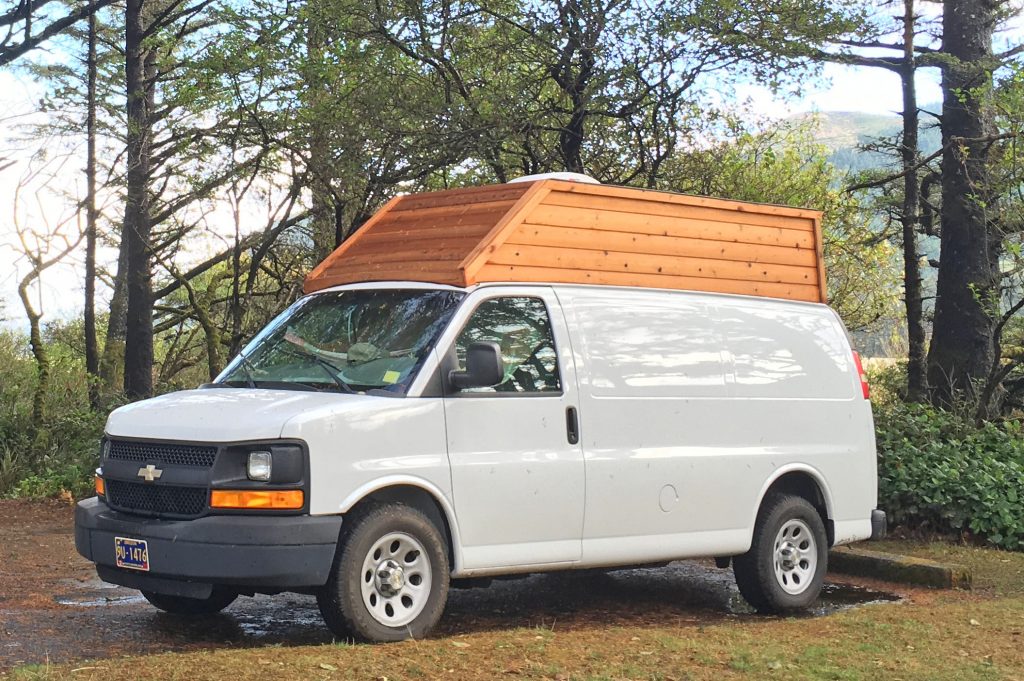What do you need in a kitchen? Like, a really tiny kitchen? Everyone’s needs will be different, but in this series breaking down Billy’s DIY campervan build, learn what he planned for, which products he used, and what he would (and might still!) do differently.
I’ve been having a hard time figuring out where to start explaining everything that went into our (mostly) DIY campervan conversion. But it’s wintertime, so let’s start where we usually hang out in the winter: the kitchen.
We’ll start our van kitchen tour with a brief annotated overview:
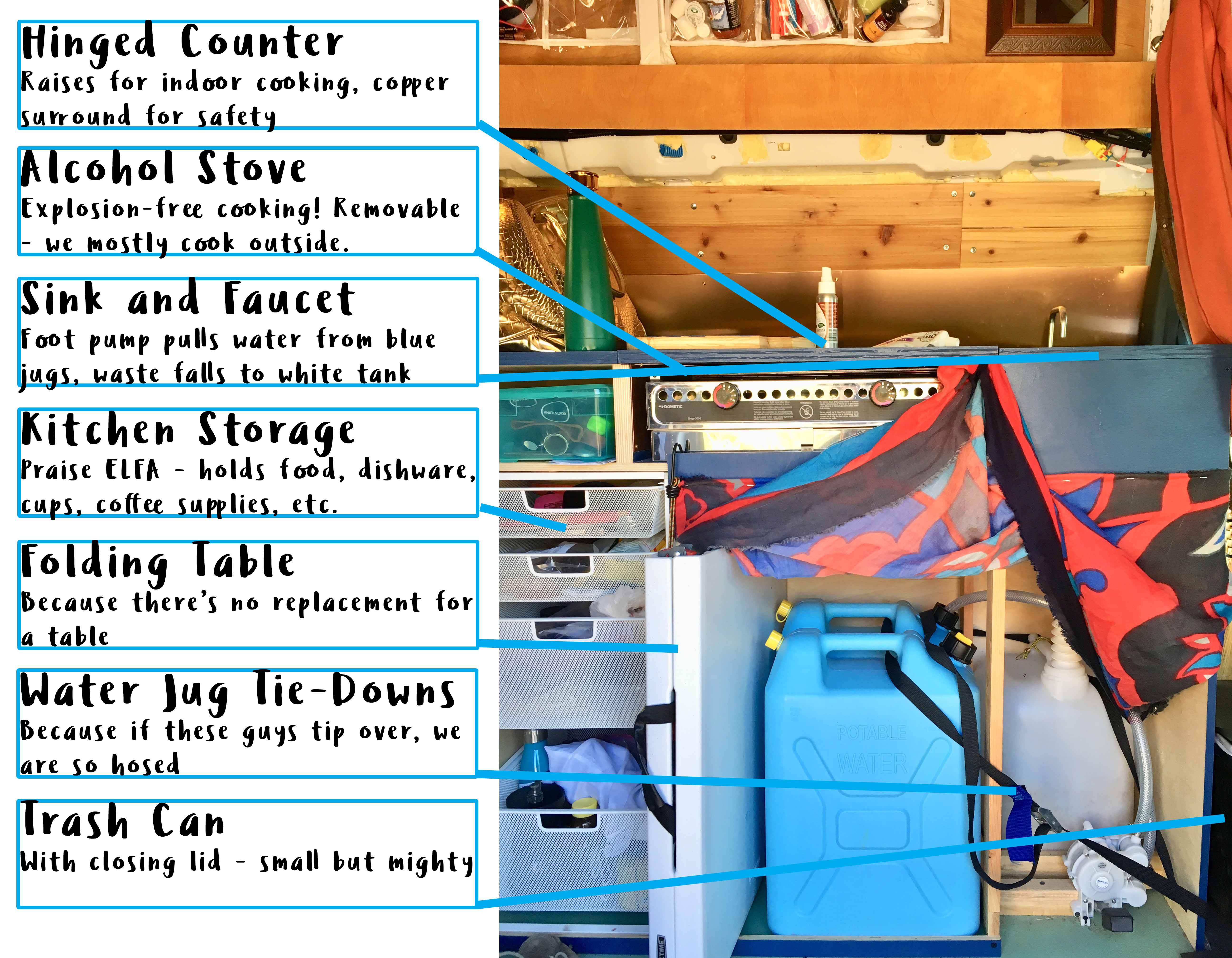
From the top view, here’s the kitchen all buttoned up for travel and serving more as one big countertop. We’ll look at it opened up a little further down the page.
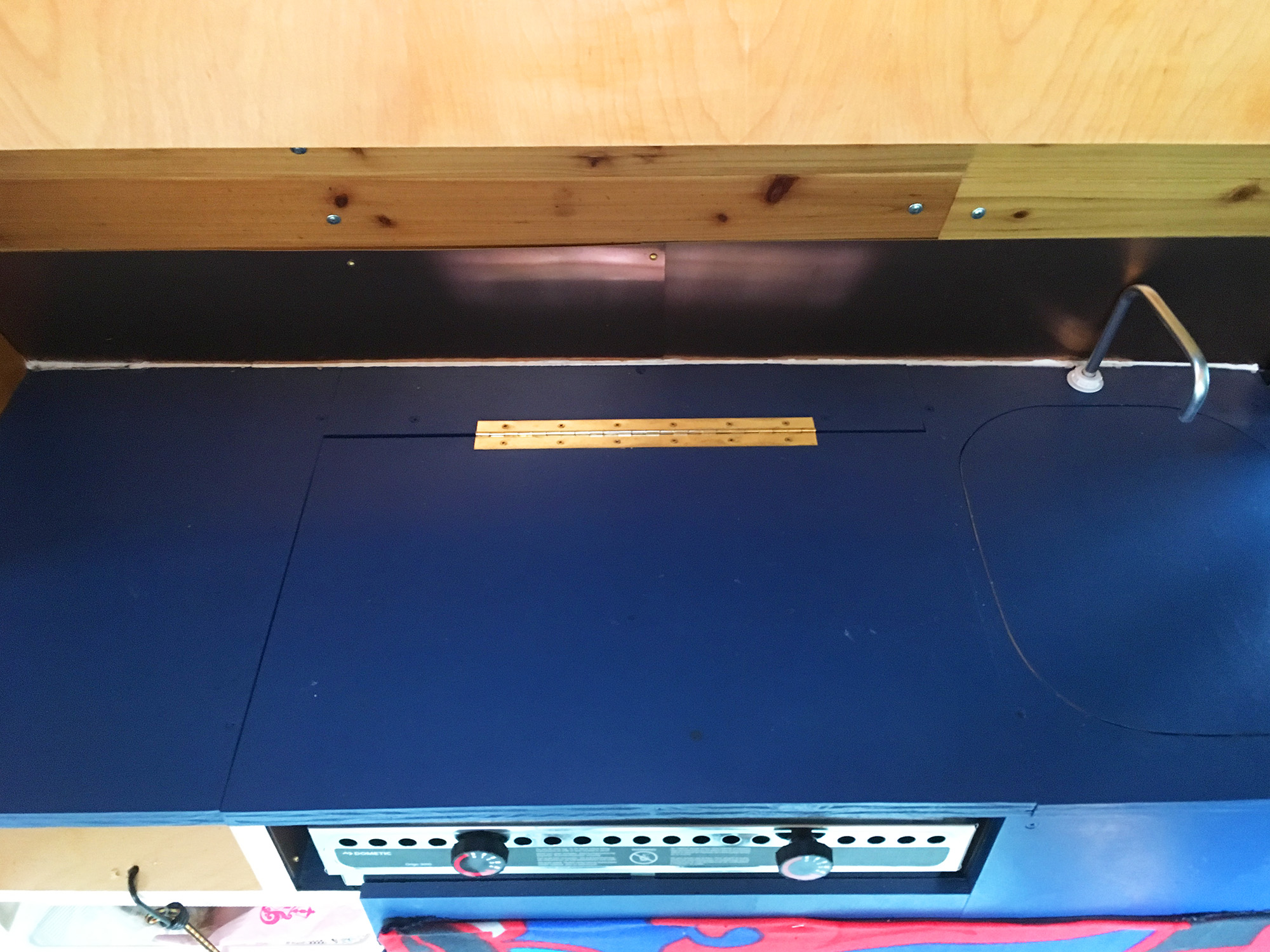
But wait, there’s still more kitchen! Tucked under the bed are two more vital elements: our “electric cooler” aka very energy efficient refrigerator, and a disorganized tub of pots and pans.
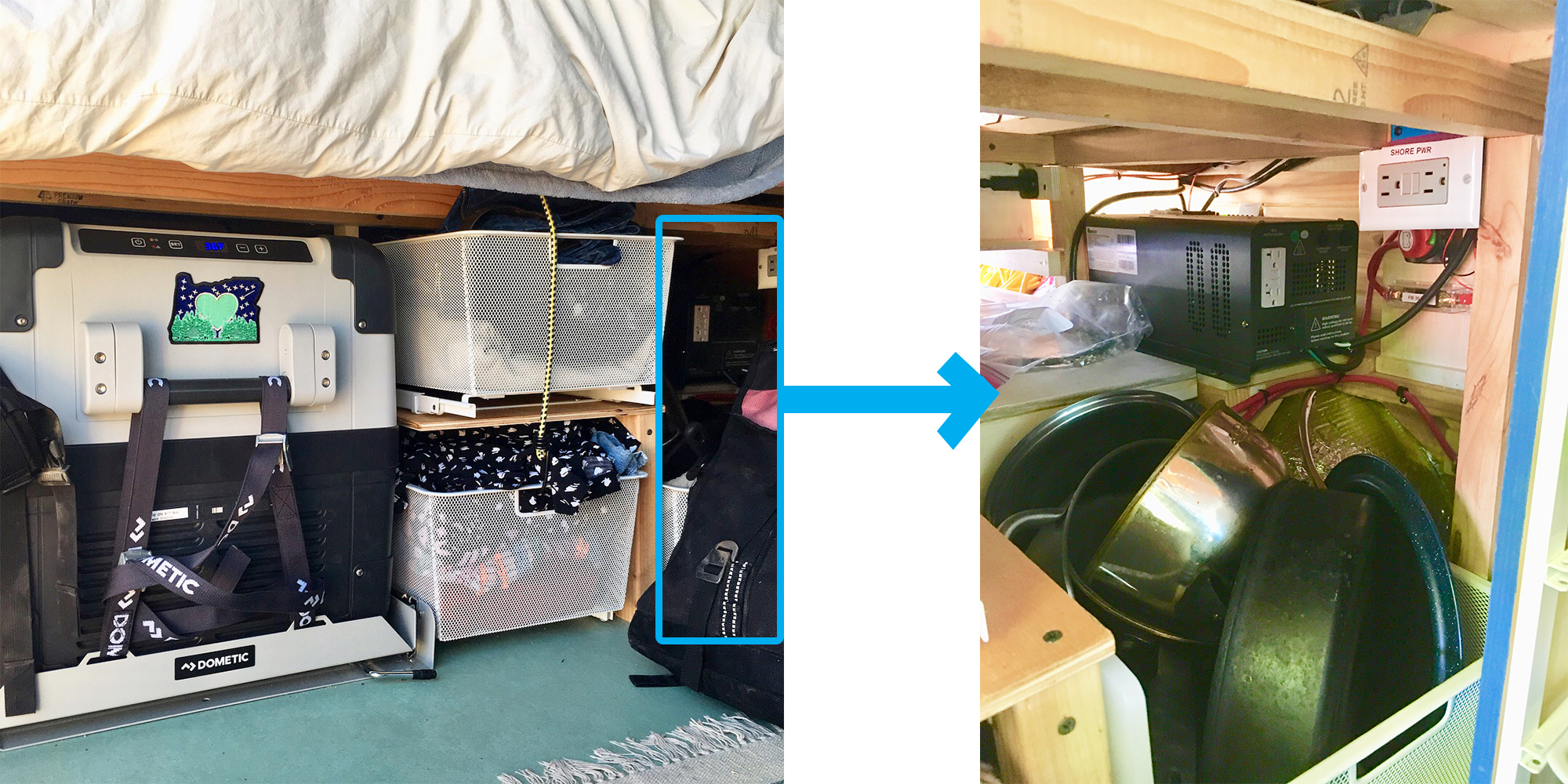
Our guiding principles for the kitchen were:
- Indoor/Outdoor Function: We wanted the option of cooking inside, but also knew that we would primarily cook outside — because it’s fun, the views are better, and there’s more room to move around.
- Make the Most-Used Systems Easy: On this, I took a tip from Bao Ying, the wise mother of one of the first people I interviewed for my Life in a Tiny House Ebook. Bao Ying advised her daughter, Candice, to choose systems for her tiny house that were as comfortable as possible for the things she’ll use all the time. For Candice, that meant choosing a flush toilet. For us, it meant having a real refrigerator instead of a cooler, and a foot-pump faucet instead of a slightly simpler but more annoying water system. Some people are comfortable with a regular cooler in their van kitchen, but we wanted a real refrigerator. Getting ice all the time and pulling wet food out of the bottom of a cooler got pretty old on short camping trips, and even though it meant beefing up the electrical system (more on that another time), we didn’t want to do that to ourselves for multiple weeks at a time.
- Fuel I’m Not Afraid Of: After some indecision, we went with an alcohol stove rather than a propane stove. Tossing out Coleman camping cylinders all the time is wasteful and annoying, but I didn’t want to build in or around a full size propane tank. As an amateur worrier, using combustible fuels like propane in confined areas always makes me a little nervous. I know the risks are low, but when given the choice, I chose the non-combustible fuel option.
- Done is Better Than Perfect: I’m better at designing as I go than at meticulously planning out a design in advance. So I designed the kitchen first to fit all the major components, then worked with the odd spaces I had left over to make them as useful as possible. As a result, some spaces are more useful than others, but I honestly don’t know how else I would have done it. If I’d tried to design for the optimal use of every inch, I wouldn’t have a kitchen at all. It would still be a pile of sticks and a messy stack of drawings.
Where to Get All This Stuff
A general note about the links below: many of these links are Amazon affiliate links, which means that they take you right to that specific product on Amazon, and Amazon gives us some fraction of the cost of the product if you buy it. I have deeply mixed feelings about this. Amazon famously underpays its workers, is squeezing great mom and pop stores out of business, and is maybe creating a monopoly on…well, the entire consumer product economy. But on the other hand, I couldn’t have found many of these products anywhere else. And when I was building on way too short a timeline and needed everything yesterday, they could almost deliver that fast. I hate to say it, but Amazon saved my van build. Sigh.
I’d like to advise anybody building a van to start first by browsing the aisles of your local RV parts store, and boat stores like West Marine. I visited a West Marine at the very end of my van build, and was surprised to find that they stocked a lot of the things I thought I would only find on Amazon. When you visit a real store in the real world, sometimes you can get what you want, exactly when you want it, AND ask a real, knowledgeable human your questions about it. When you can buy from a real store – do!
What We Installed in Our Van Kitchen
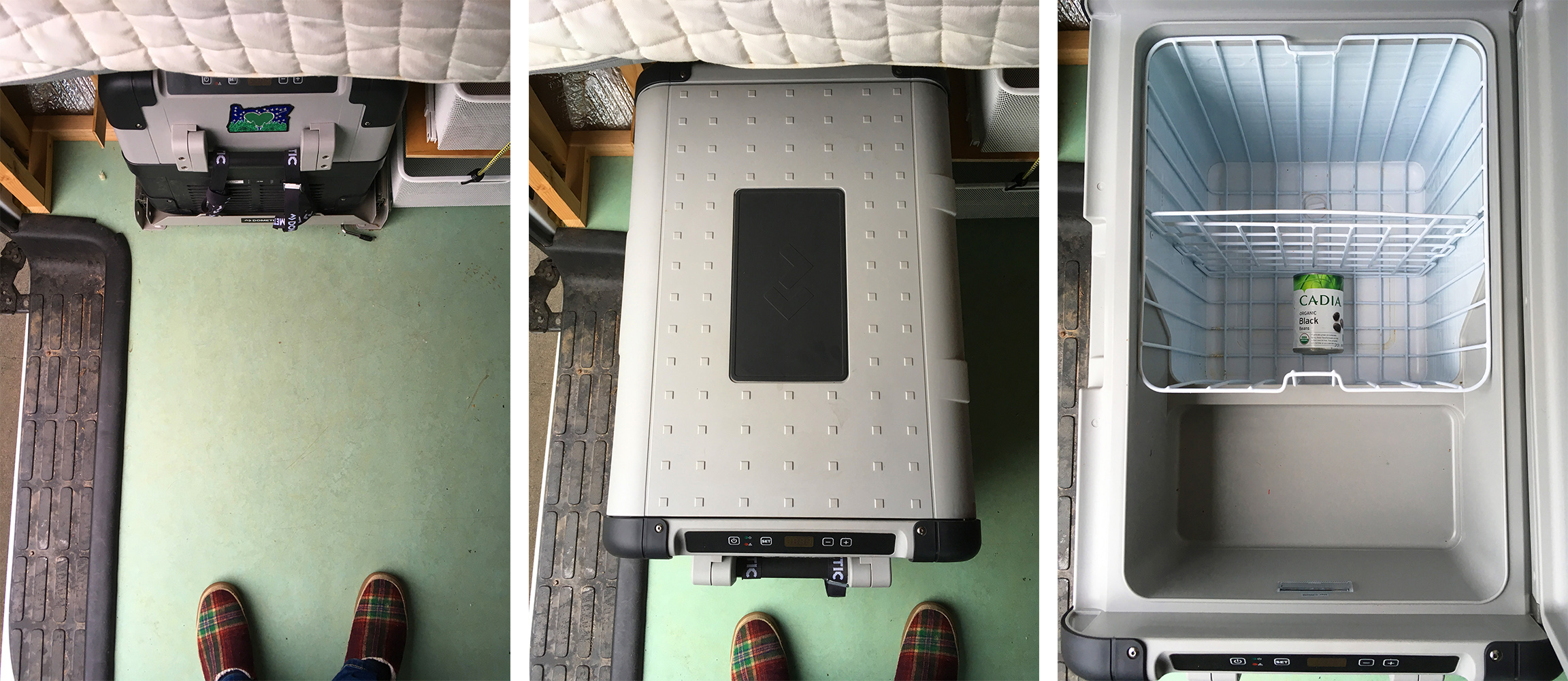
Refrigerator / “Electric Cooler”
The first major decision we made was on the fridge. We chose the Dometic CFX 50W Electric Cooler. It probably costs about as much as the giant fridge in your house, but it’s super energy efficient, really solidly built, held everything we needed it to and more, and performed fantastically for us. Zero complaints.
We also bought the sliding rack that fits our model, and it also performed perfectly. I hesitated at that purchase and considered DIY rigging something else to achieve the same purpose, but I’m so glad I didn’t. As soon as I screwed this pre-made piece of hardware down into the floor, all the hours I would have wasted creating a DIY system flashed before my eyes, and my heart was happy.
We wouldn’t change anything about our fridge choice. I waffled over size, but the 50 was perfect for us. I thought we would have to skimp on chilled beverages to save space for perishable food, but we actually had a bottle of celebratory champagne in the fridge for our entire six week trip. We never felt like drinking it, but we also never needed to take it out to fit more food.
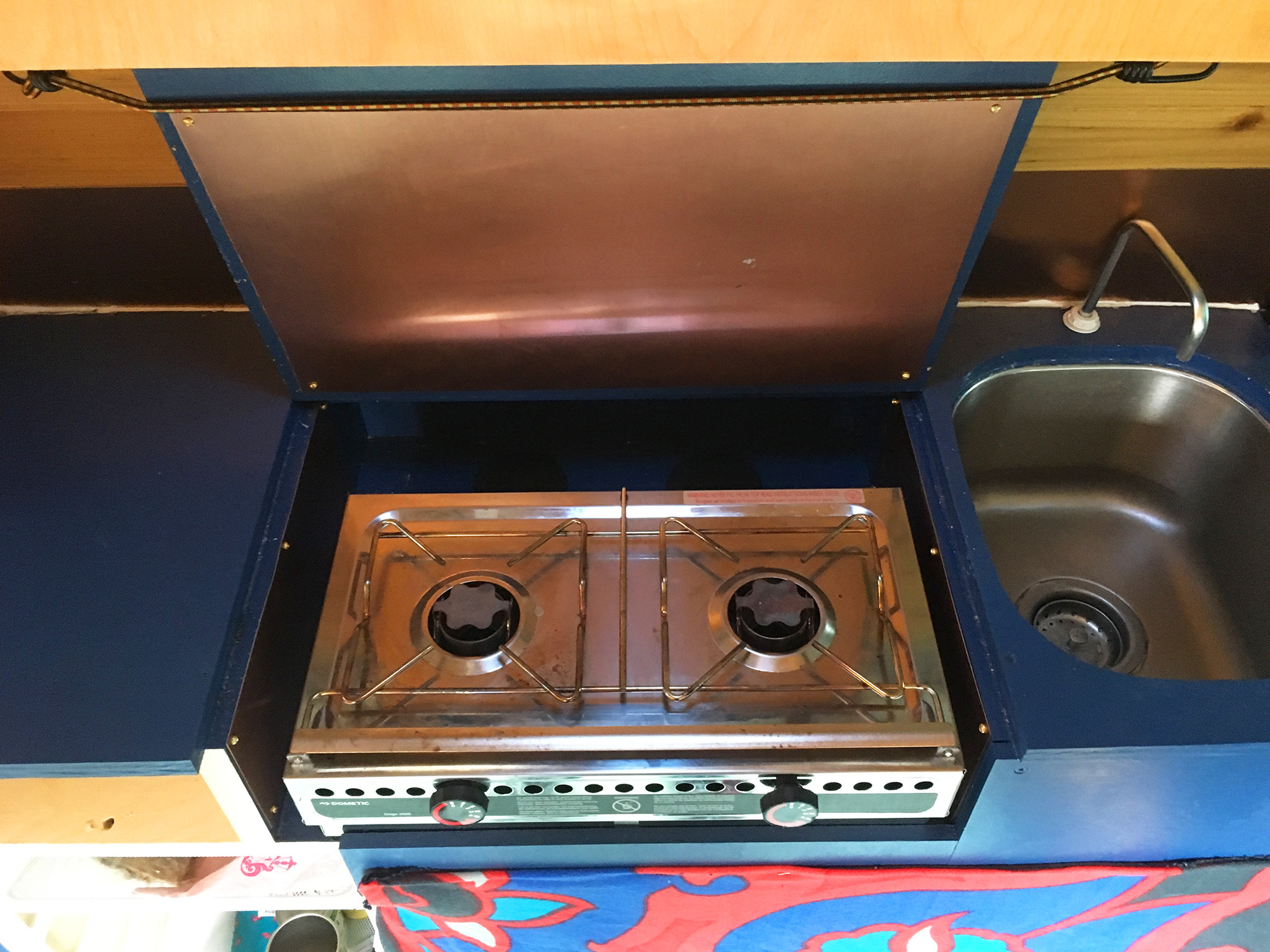
Sink, Faucet and Water System
We got the tip of the Whale Systems Gusher Galley Foot Pump Faucet system from the fine folks at Gnomad Home. If you have not seen their van build guide, man, just leave this page now and go over there. I used their guide and product recommendations extensively. I combed the internet for weeks, maybe months of my life, and I honestly haven’t seen a better DIY van guide anywhere.
The Whale Systems Foot Pump matches their specific telescoping faucet, which I bought from BoatStoreUSA online. We shopped around for stainless steel bar sinks until we found a size we were comfortable with. For fresh water supply, we went with two five gallon BPA-free water jugs from West Marine. The foot pump has beverage tubing coming out of two ends: one end goes into one of the two fresh water jugs, and the other end feeds up to the bottom of the faucet. When one jug ran out, I either refilled it, or just fed the tube into the other jug.
The wastewater from the sink drains into a normal flexible sink extender tube, which drains into a five gallon wastewater jug. This jug doesn’t have to be BPA free or anything fancy, because nobody’s drinking out of it. I really wanted jugs like these to be available in every conceivable size and shape, but somehow there were only a few options, and this was the best I could find for the space we had.
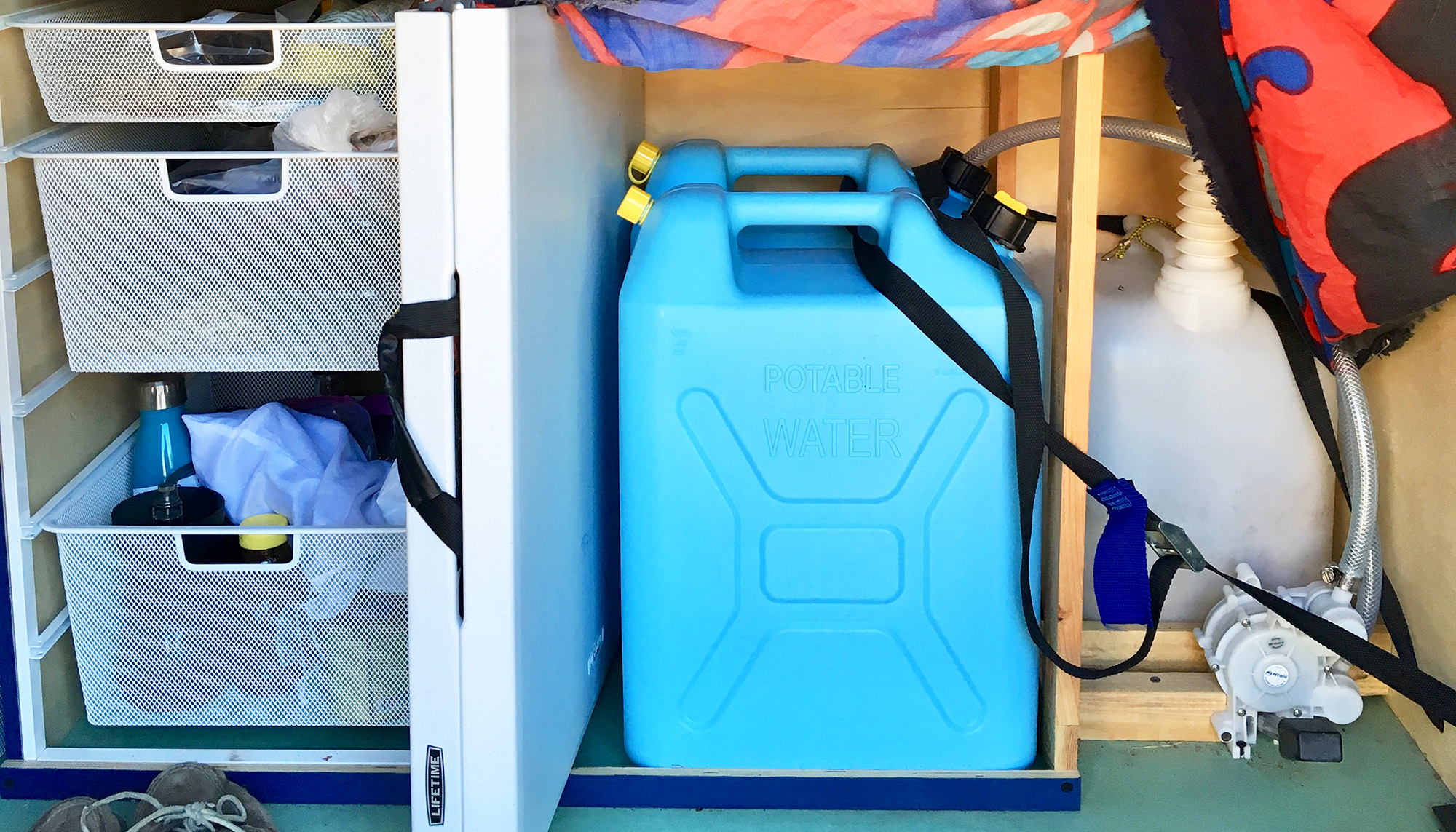
We were happy with our water system in the end, and have no plans to change anything there. A bigger sink would always be nice, but not at the expense of our otherwise minimal counter space. I was frustrated with the size of our wastewater jug at first, because we only ever fill it up to about 1/4 full before dumping it, but all that extra space in the jug turned out to be helpful. To pull it out and dump it, I’d unhook the tie downs, push the flexible sink tailpipe up, and tilt the whole jug sideways to slide it out from under the sink. So if the jug were much smaller, I’d be cruising for a really disgusting spill every time I did that.
The foot pump sink system is awesome – it was a snap to hook up, moves water like magic with zero electricity, and none of the connections have spilled a rogue drop. When we got home to our standard, house sink, I actually reached for the foot pump with my foot a few times because the pump was second nature to me by then.
Alcohol Stove
As I mentioned above, propane just kind of freaked me out. I didn’t want to go through a ton of 1 lb Coleman camping propane cylinders, but I also didn’t want to hook up a full size propane tank. Some people fit them under their vans — “What if we drive on weird four wheel drive roads and puncture it???” I catastrophized. Some people attach them to the outside of their vans — “What if someone steals it??” I worried. And some people store them indoors in properly ventilated cabinets…that I didn’t want to figure out how to create.
Enter: the Dometic alcohol stove. The wise folks at Gnomad Home pointed out that for some reason, having these shipped from Amazon.co.uk is cheaper than buying them in America, so that’s what I did.
While taller than a propane stove, since the fuel rests below the burners instead of off to the side, this unit fits nicely in a little cabinet area I made for it when we drive or cook indoors. While I want to cook outside whenever possible for a million reasons, I can also just raise the lid on this area in the van, and cook inside. The underside of the hinged counter area around it has copper sheeting to protect the wood cabinet from the heat of cooking, and from messy splashes.
After using it as our sole cooking method for six weeks, this stove is great. I heard it didn’t run as hot as propane, but I never felt like it was slowing me down. I also heard the temperature could be harder to control, but I didn’t find it any more difficult than my old Coleman propane stove. Finding the appropriate fuel was easy and cheap – even the most remote places typically have either a hardware store or a Walmart, and they both sell denatured alcohol.
The only thing I plan to change about our stove set up is creating some kind of wind break for the stove. I thought maybe it wasn’t affected by wind because it didn’t come with any kind of wind screen, but some very windy campgrounds proved that very wrong. With a few sheets of tin and clips of some kind, we’ll be totally satisfied with its performance regardless of the weather.
Food and Kitchen Storage
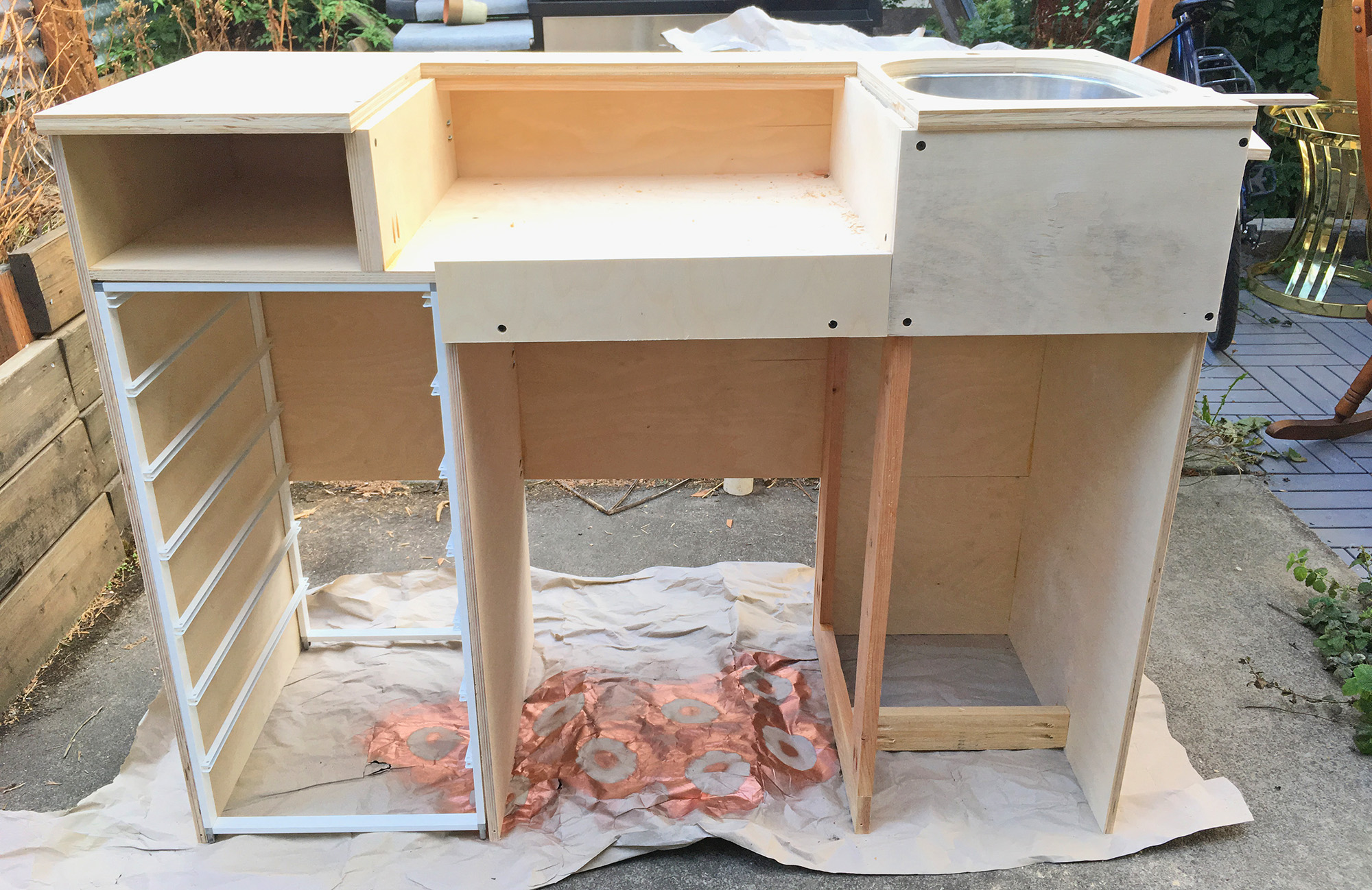
Designing for the main components of the kitchen was a real head-scratcher for me for quite a while. The largest components were the fridge (which would be under the bed, not in the main kitchen cabinet), the stove, the sink, and the water jugs. I tried to get all those pieces as compact as possible, but also wanted a plug-in storage option that I didn’t have to work at. So the first thing I did was look at the Elfa storage options at the Container Store.
If you want to create custom cabinets for all your little van niches, more power to you! But I was happy to find a work around for all those time-consuming steps, and find an Elfa storage size that would fit into my kitchen area. Elfa storage is often seen in walk-in closets that cost as much as our van, but they actually have a ton of other products and options. The frame itself is one piece, which comes in different widths and heights, and the drawers that sit in it also come in a variety of heights, so you can choose deeper and shallower drawers where they suit you.
I’ve had some of these in my home kitchen for years, so I know that they’re basically indestructible and very light weight. When I found a set of components that worked for our general kitchen area, I was psyched, and designed the wooden kitchen cabinet around that set of shelves.
To my surprise, one rack of Elfa shelves held the majority of our dry food and dishware. I had worried about food storage in the van, because it’s always a huge chunk of what we take camping, but a lot fit into this little area. We had one shallow drawer for plates, cups, silverware and napkins, one shallow drawer for easy snacks, one deep drawer for dry foods like pasta and beans, and one deep drawer for our coffee supplies, cooking oils, paper towels, and other odd sized items.

But what about the pots and pans we cook in? That’s the area we still need to improve upon. On this trip, I just had one deep Elfa drawer sitting on the ground under the bed, in an odd corner nook left over where the kitchen meets the electrical system. I pulled pots and pans out of there as needed, but doing that repeatedly was a pain. I was jealous of some van friends we met up with on our trip who had their whole outdoor kitchen stored in one giant tupperware bin. I felt like I was making a million trips into and out of the van to grab things, even for simple meals.
That’s my main storage puzzle to solve from here: since we prefer cooking outside, I’ve got to get all the outdoor kitchen items into one box somehow, for easier transport.
Table, Trash Can, and Everything Else
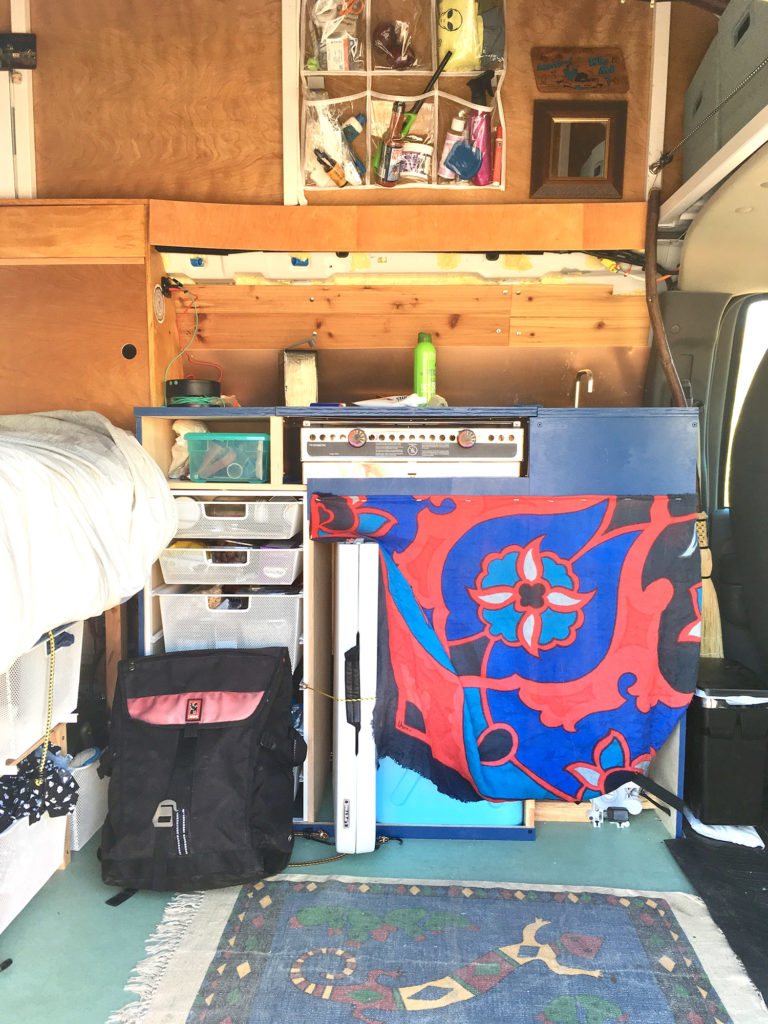
Some other vital elements of our kitchen include:
- A fold out table. Have you ever gone camping where there was no table? Yeesh, cooking on the ground and squatting over the stove is hard on the knees, and in my experience, causes a lot of burnt potatoes. We didn’t end up needing it too often, but when you need it, there is no substitute. And luckily, it snugged in to an otherwise useless space next to the water jugs.
- A trash can with a lid. I think I assumed we would just hang a plastic bag from a nail and dump our garbage in there, until my wife handed me a sporty, compact trash can with a lid at the Container Store. A fully enclosed trash can is pretty vital in a small space – no smells, no spills, and it hangs on a little rack in another otherwise useless space behind the base of the driver’s seat.
- Tidy storage pockets. This was another invention of my brilliant wife, who excels at storage and organization. She picked up a series of plastic shoe organizers, which she cut up and velcroed to the walls of the van. Each pocket was like a drawer in our house: one for tooth brushes and toothpaste, one for dish soap and sponges, one for salt, hot sauce and condiments. The pockets above the sink transitioned smoothly from kitchen storage to bathroom storage, then into other useful items like pens, scissors, charging cords, camera film, and collectible National Park brochures. Over time we’d like to replace these with something a little prettier, but they were an absolute lifesaver. In a small space, it’s tremendously valuable to know that everything has a specific place.
That’s the kitchen in Van 2.0, as we’ve come to call it. The van already had a couple design phases before the big build out push for our first six week trip, and I’m sure it will see many continued alterations in the future. Stay tuned for additional posts on other aspects of the van design, like our electrical system, our storage system, how we hang out, and more!
